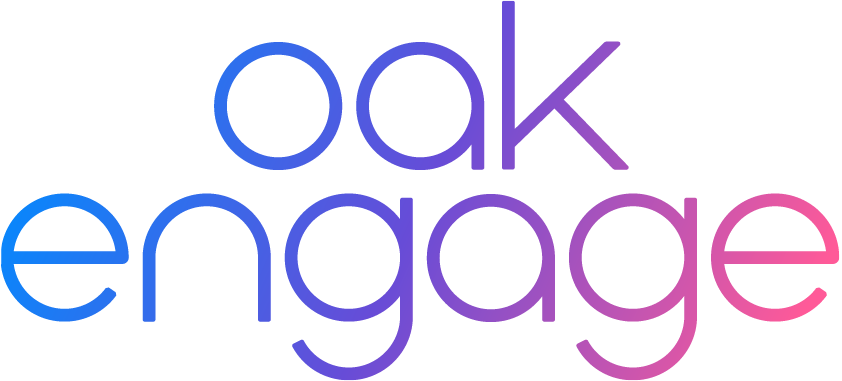Leading Blink Alternatives for 2025: The Best Platforms for Frontline & Enterprise Communication
Looking for Blink alternatives? Frontline communication tools have become essential for modern organisations, especially those with dispersed, shift-based, or mobile workforces. Blink has become a well-known option in this space, offering a mobile-first employee app centred around fast updates, social feeds and frontline engagement.
But as organisations mature their internal communication strategy, expand beyond frontline-only use cases, or require more structured content, governance and analytics, many begin looking for Blink alternatives that offer deeper capabilities, stronger scalability, or a more unified employee experience across both deskless and desk-based employees.
If you're exploring the best Blink alternatives in 2025, this guide provides a structured, ranked comparison of the top platforms available today — blending objective feature assessment with real buyer switching behaviour to show which solutions organisations actually choose when moving beyond Blink.
Why Organisations Look for Blink Alternatives
Blink provides a solid mobile-first experience, but doesn’t meet every organisation’s needs — especially as internal comms functions mature. The most common reasons companies explore alternatives include:
1. Stronger content management & governance
Blink’s structure is limited for organisations with compliance, policy management or complex knowledge requirements.
2. Serving both frontline and office-based employees
Many organisations now want a single platform, not a “frontline-only” tool.
3. Intranet-level functionality
Blink focuses on updates and social feeds — not hubs, pages, search, or lifecycle management.
4. Personalisation & AI targeting
Modern comms requires delivery based on role, priority, location and behaviour — areas where Blink is limited.
5. Scalability & analytics
Organisations often outgrow Blink as they expand communication workflows and require richer insights.
If any of these challenges resonate, it’s time to evaluate the wider employee experience landscape.
How We Selected the Best Blink Alternatives
Our ranking blends:
Feature & capability depth (A)
Real-world switching patterns from Blink (B)
Each platform was evaluated on:
-
Mobile & frontline capability
-
Content management depth
-
Internal comms workflows
-
AI & personalisation
-
Design & user experience
-
Governance & compliance
-
Analytics & reporting
-
Frontline vs office suitability
-
Implementation effort
-
Pricing flexibility
-
Adoption patterns from Blink customers
The 13 Best Blink Alternatives for 2025 (Ranked)
Ranking combines the two models above.
| Rank | Platform | Best For | Why Chosen Over Blink | Key Strengths | Limitations |
|---|---|---|---|---|---|
| 1 | Oak Engage | Unified workforce communication & intranet | Organisations want structure, AI targeting, governance & mobile in one place | Intranet + comms + mobile app, AI personalisation, strong governance, analytics | Requires initial planning |
| 2 | Workvivo | Social-style engagement & culture | More polished social features and recognition tools compared to Blink | Social feed, strong UX, mobile-first, branded comms | Limited structure and governance |
| 3 | Staffbase | Comms teams | Editorial workflows, branded apps, multi-language comms | Publishing suite, strong governance, enterprise integrations | Premium pricing, heavier rollout |
| 4 | Firstup | Global-scale automated workforce orchestration | Automation, multi-channel delivery, data-driven targeting | Automation, analytics, personalisation | Complex setup, enterprise tier pricing |
| 5 | Unily | Enterprise-grade intranet | Deep content structure, customisation, multilingual support | Highly customisable, strong governance, enterprise CMS | Expensive, lengthy implementation |
| 6 | Interact | Regulated & compliance-driven organisations | Strong policy management, mandatory reads, structured content | Mature intranet features, strong search, governance | Older UI, less social/mobile engagement |
| 7 | LumApps | Google Workspace organisations | Workspace integration, multilingual hubs, flexible content | Google-native, strong multilingual support, flexible design | Higher cost, implementation complexity |
| 8 | Simpplr | Governance & content quality control | Predictable workflows, AI maintenance, content control | Governance-first design, insights, clean UX | Less frontline-friendly, limited social features |
| 9 | Happeo | Simple intranet + Google integration | Simplicity, easy navigation, Google Drive alignment | User-friendly, Google-centric, lightweight | Limited governance, not frontline-first |
| 10 | MangoApps | Value-focused all-in-one platform | Broader tooling than Blink, including ops workflows | Affordable, operational tools, modular features | Busy UI, can be overwhelming |
| 11 | Beekeeper | Operational frontline teams | Shift workflows, automation, operational efficiency | Task/shift tools, workflow automation, mobile-first | Not an intranet, limited content structure |
| 12 | Sociabble | Advocacy & brand amplification | Campaign-led engagement, gamification | Advocacy tools, gamification, strong social UX | Not suited for structured internal comms |
| 13 | Workplace from Meta | Familiar social UX during transitions | Easy adoption due to Facebook-style interface | Very intuitive, community-focused | Product discontinued, no roadmap |
1. Oak Engage — Best for mid size to enterprise organisations
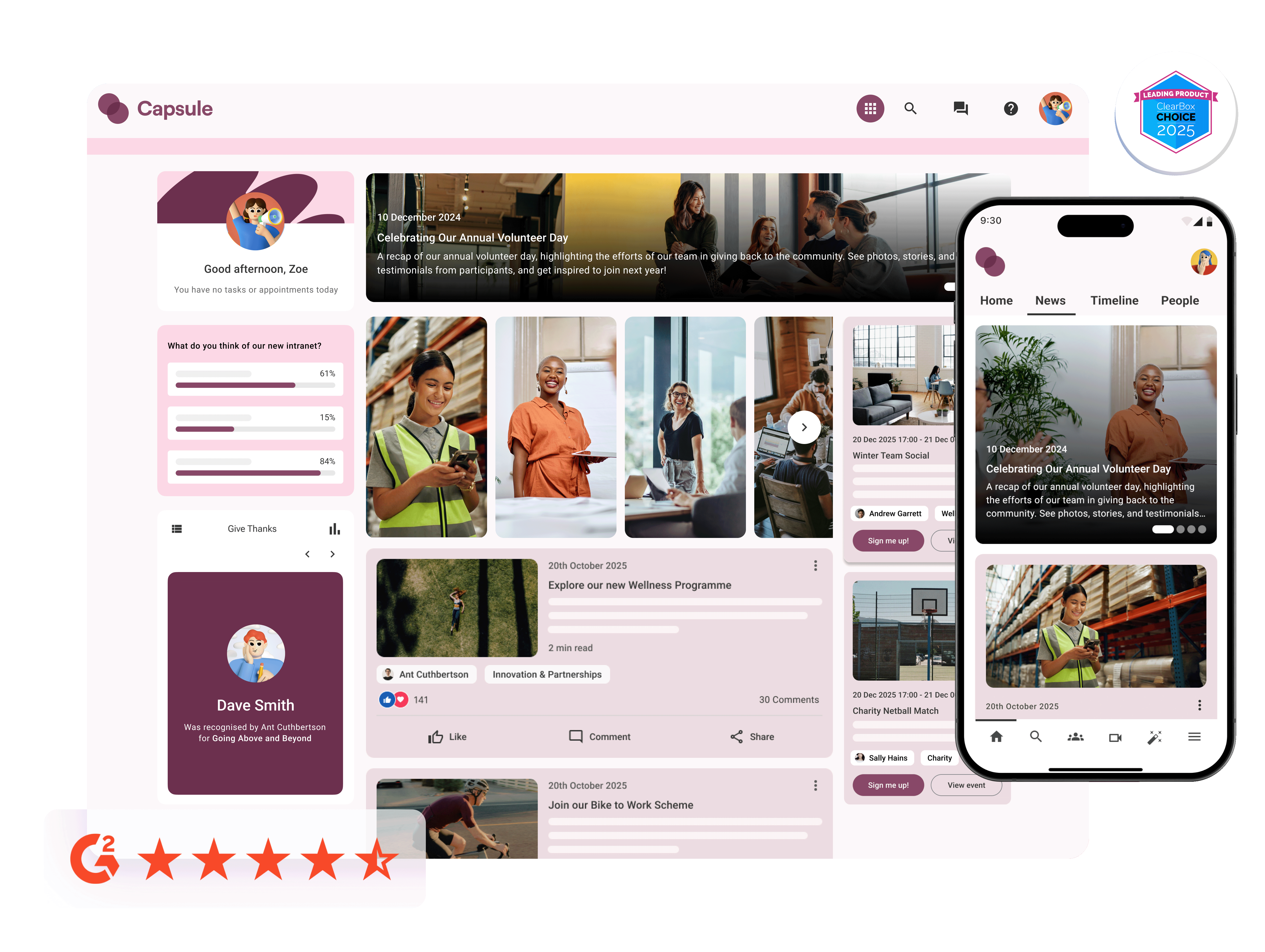
Blink remains a strong, mobile-first platform for frontline communication but when organisations assess the two platforms side by side, Oak Engage consistently comes out ahead across communication effectiveness, content engagement and long-term scalability.
Many companies start with Blink because it’s simple and social. But as communication requirements become more strategic, the need for structure, governance and personalisation leads them toward Oak Engage. The performance data makes this trend even clearer.
Oak Engage stands out as the strongest overall alternative to Blink because it delivers far more than just mobile communication. Organisations adopt Oak when they need a single platform that supports both frontline and office-based employees with a complete blend of structured content, modern internal comms, social interaction and AI-powered personalisation. While Blink focuses mainly on mobile updates and social feeds, Oak Engage combines a full intranet, advanced content governance, hubs, policies, communities, analytics and Smart Delivery AI, all designed to improve communication accuracy and reduce noise across the entire workforce.
Companies moving away from Blink typically do so because they require features Blink simply doesn’t support at scale such as structured pages, knowledge hubs, governance workflows, content versioning and detailed analytics. Oak Engage gives internal comms teams far more control over message targeting, scheduling, layout and measurement, while still offering the mobile experience frontline workers rely on. It’s this dual capability (frontline and office) that makes Oak the most future-ready alternative for organisations seeking long-term evolution of their communication ecosystem.
Pricing for Oak Engage is custom-quoted, as it depends on organisation size, modules needed (intranet, comms, engagement, AI, mobile app), and onboarding scope. There are no fixed public price tiers, so organisations should request a tailored quote directly from Oak Engage to get accurate enterprise pricing.
Across core communication metrics:
-
Oak Engage scores 9.0/10 vs Blink’s 8.5 for overall communication effectiveness
-
Oak scores 10/10 in news feed quality vs Blink’s 9.2
-
Notification performance is 9.7/10 for Oak vs 8.9 for Blink
-
Content interaction on Oak hits a perfect 10/10, including commenting and engagement signals
This reflects a fundamental difference in how each platform delivers information.
Blink’s feed is fast and social, but Oak’s structured approach — combined with Smart Delivery AI — ensures employees receive more relevant content, at more relevant times, across more relevant channels.
Oak Engage also outperforms Blink in long-term support and customer success, with:
-
Support quality: Oak 9.6 vs Blink 9.2
This matters especially for organisations undergoing communication transformation or unifying frontline and office-based workforces.
Where Oak Engage leads
-
Intranet + comms + engagement in one platform
-
AI-powered targeting and personalisation
-
Stronger communication impact across all employee types
-
Higher-quality content engagement and visibility
-
More robust governance and content lifecycle management
-
Better scalability for enterprise environments
The result?
Blink is excellent for quick frontline messaging.
Oak Engage is built for enterprise-wide communication, structured knowledge, and meaningful engagement.
Want to see how Oak Engage compares against Blink in more detail?
This is why organisations upgrading from Blink most commonly choose Oak Engage — especially once they require a unified platform that works for frontline, hybrid and desk-based teams alike.
2. Workvivo — Best social-style Blink alternative
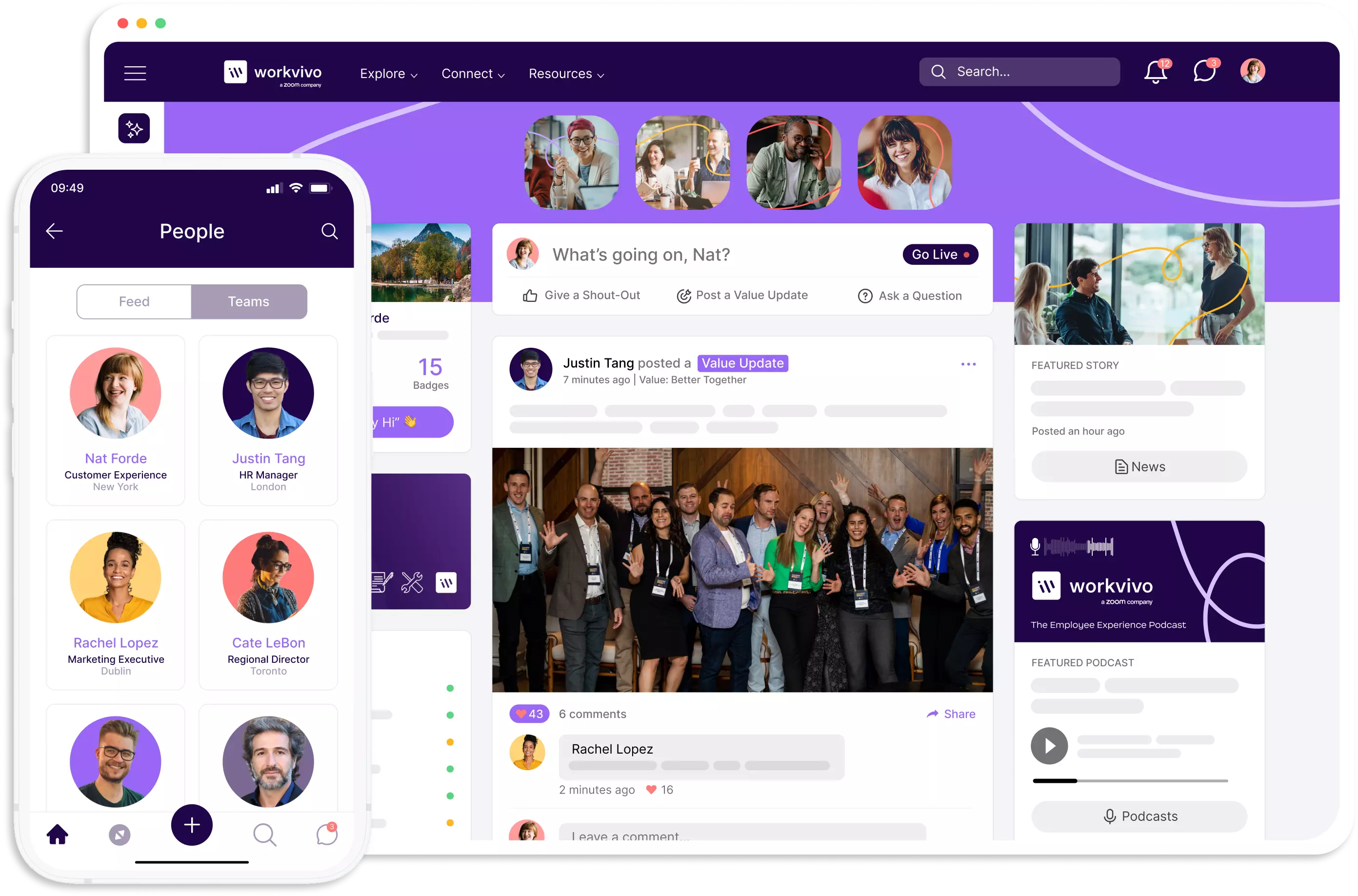
Workvivo is often chosen as an alternative to Blink when organisations want a more polished, modern social experience rather than a traditional intranet or structured content system. Its interface feels similar to a consumer social platform, making it extremely easy for employees to post updates, share recognition, celebrate moments and participate in community discussions. For companies prioritising culture, visibility and community engagement, Workvivo provides one of the most intuitive employee experiences on the market.
Compared to Blink, Workvivo delivers a more branded, richer social-feed environment with embedded recognition, celebrations, shoutouts, podcasts, and community spaces. It also includes stronger content presentation and more polished storytelling tools. However, Workvivo does not offer the same level of structured content organisation, governance or AI-based targeting available in more holistic platforms like Oak Engage. This makes it ideal for organisations seeking cultural connection and employee-generated content rather than deep content management or enterprise governance.
Workvivo follows an enterprise pricing model with no public per-user rates listed. Pricing varies based on modules, organisation size and rollout complexity, so companies should request a custom quote from Workvivo to determine the exact investment required.
How it compares to Blink
-
More polished design
-
Better recognition tools
-
Richer social features
-
More content flexibility
But still not designed for structured content or intranet-level governance.
Strengths
-
Engaging social feed
-
Excellent branding and UX
-
Great for culture and employee voice
Limitations
-
Limited content governance
-
Not ideal for policies or structured pages
Best for
Organisations wanting a social, community-focused platform.
3. Staffbase — Best unified comms platform

Staffbase is a top Blink alternative for organisations with dedicated internal communications teams that require newsroom-level publishing workflows, branded employee apps, editorial governance and multi-channel orchestration. Unlike Blink — which centres primarily on frontline updates — Staffbase is built for strategic, enterprise-wide communication, offering advanced planning, scheduling, governance and measurement tools that give comms teams full professional control over their messaging.
Organisations switching from Blink to Staffbase often do so because they need a broader communication ecosystem: branded mobile apps, multilingual content distribution, email newsletters, targeted announcements, executive updates, and governance rules that maintain consistency across global teams. Staffbase also supports campaign management and cross-channel reporting, enabling internal comms leaders to measure performance and optimise future communications.
As with most enterprise-grade platforms, Staffbase operates on custom pricing, with costs depending on organisation size, modules (email, app, desktop, comms hub, etc.), support model and branding needs. Staffbase does not publish public price tiers, so organisations should request pricing directly from Staffbase for accurate estimates.
How it compares to Blink
Staffbase is chosen when organisations need:
-
Professional editorial workflows
-
Multi-language communications
-
Multi-channel orchestration
-
Enterprise-level branding
Strengths
-
Excellent publishing tools
-
Strong governance
-
Branded apps
Limitations
-
Premium pricing
-
Heavier implementation
Best for
Large comms teams and enterprise environments.
4. Firstup — Best for global-scale workforce orchestration
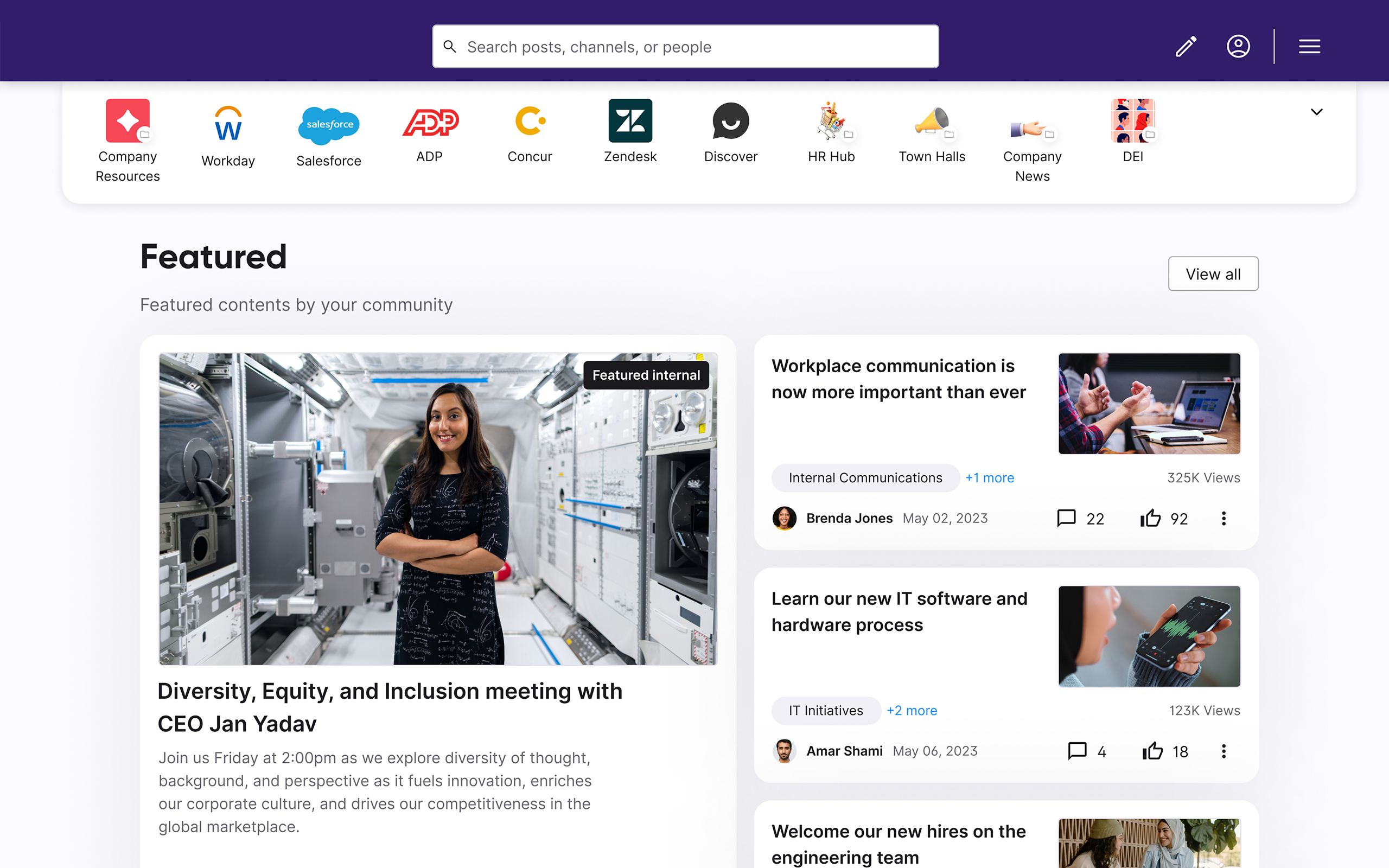
Firstup specialises in communication automation and personalised delivery at scale, making it one of the best Blink alternatives for large, distributed organisations that need intelligent orchestration across many regions and audiences. Unlike Blink’s simple feed-based model, Firstup uses behavioural data, segmentation rules and automation workflows to deliver personalised updates across mobile, desktop, email, SMS and other channels — ensuring employees receive the right information regardless of how they interact with content.
When companies migrate from Blink to Firstup, it’s typically because they’re ready to level up from manual communication to automated journeys and advanced content targeting. Firstup allows organisations to create behaviour-triggered campaigns, analyse engagement patterns, and refine communications with data-driven insights. It is particularly strong for enterprises with large, complex workforces that require both flexibility and rigor in their communication approach.
Firstup’s pricing is fully custom and quote-based, due to the platform’s enterprise focus and the wide variation in use cases. Organisations exploring automation, global communications or AI-driven targeting should request a tailored quote from Firstup to receive accurate pricing information based on their scale and requirements.
How it compares to Blink
-
More enterprise-grade
-
Better automation
-
Stronger targeting
-
More analytics
But also more complex.
Strengths
-
Intelligent automation
-
Multi-channel delivery
-
Deep analytics
Limitations
-
Complexity & higher cost
Best for
Large global enterprises.
5. Unily — Best governance alternative
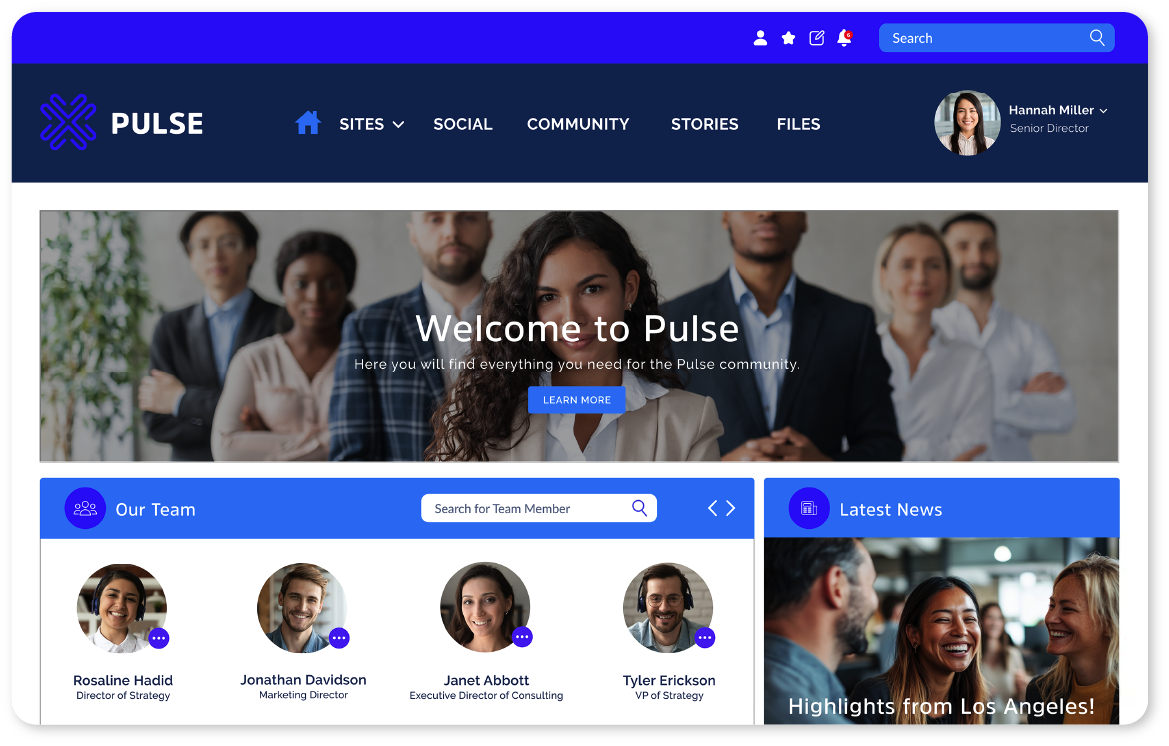
Unily stands out as a powerful enterprise-grade employee experience platform that goes beyond simple frontline mobile apps. Where many employee engagement apps focus on social feeds or mobile updates, Unily provides a full intranet experience: deep content management, global navigation across multiple geographies, strong multilingual support and a sophisticated framework for building branded experiences. For organisations switching to a more mature engagement platform, Unily is often selected when a company realises that its communication and knowledge needs have outgrown a basic mobile-first engagement solution.
For businesses moving from more frontline-centric or mobile-only apps (like some simpler employee engagement apps) to a unified company-wide platform, Unily offers the structure, scalability and flexibility required. It allows engagement teams to build hubs, communities, knowledge bases and target content by role, location or language – far beyond what many traditional engagement apps provide.
In terms of pricing, Unily does not publish fixed user-based tiers online; instead it offers custom quotes tailored to company size and module selection. For example, quotes for large enterprises start at significant annual spend (see site for details) and the cost will vary depending on users, features, branding, modules and services.
How it compares to Blink
Organisations switch from Blink to Unily when they need:
-
True intranet structure
-
Branded digital experiences
-
Robust governance
-
Deep multilingual capability
Unily’s strength is depth — and its challenge is complexity.
Strengths
-
Full-featured, enterprise intranet
-
Highly customisable
-
Advanced governance & multilingual features
Limitations
-
High cost
-
Heavier implementation than Blink
Best for
Global enterprises with mature digital workplace requirements.
6. Interact — Best for policy & compliance-focused organisations

Interact is designed for organisations where communication is not just about engagement but about ensuring content is seen, actioned and governed. Unlike typical “employee engagement apps” that emphasise likes, comments and social feed interactions, Interact is built with mandatory reads, content lifecycle management, workflows and enterprise search at its core. This makes it especially relevant for industries like finance, healthcare or manufacturing where compliance, training and policy read-through are critical.
When companies transition from simpler engagement platforms to something like Interact, the shift often comes when they need better analytics, better content discoverability and stronger control over who sees what and when. Interact provides these capabilities while still offering a mobile-friendly interface, making it a credible engagement app with heavy-duty governance backing.
Regarding pricing, Interact offers customised quotes based on user count and modules.
How it compares to Blink
Blink’s free-flowing feed doesn’t support mandatory reads or policy management at scale. Interact fills that gap with:
-
structured hubs
-
mandatory reads
-
robust search
-
governance and version control
Strengths
-
Mature content and policy features
-
Strong search
-
Governance-first design
Limitations
-
Not as mobile/social as Blink
-
Older-feeling interface
Best for
Regulated industries: healthcare, finance, government.
7. LumApps — Best for Google workspace-centric organisations

LumApps specialises in bridging the gap between engagement, communication and intranet functionality — particularly for organisations already using Google Workspace. Its strength lies in combining social engagement tools, knowledge hubs and page-building capabilities with strong search and mobile access. Many companies adopt LumApps when they realise that their frontline and distributed employees need more than basic mobile updates, they need a combined engagement, knowledge and communication platform.
Switching from a basic engagement app to LumApps often occurs when a company wants greater content structure, multi-language support, targeted messages and full mobile + web experiences rather than just mobile notifications. LumApps gives teams the ability to build pages, communities and hubs while still delivering mobile-first experiences for employees on the go.
For pricing, LumApps provides “per license package” pricing rather than a fixed public list.
How it compares to Blink
-
Offers deeper content design
-
Structured knowledge hubs
-
Multilingual & multi-entity support
-
Full intranet experience
But is less frontline-heavy than Blink.
Strengths
-
Google-native integration
-
Rich design control
-
Strong multilingual features
Limitations
-
More complex to implement
-
Higher pricing
Best for
Google-focused organisations needing a full intranet.
8. Simpplr — Best for content governance & predictability

Simpplr is built for organisations that value consistency, governance and predictable engagement over flashy social features. Unlike more informal engagement apps that emphasise social posts and mobile chat, Simpplr emphasises structured content, AI-driven content optimisation, and strong analytics. Organisations switching to Simpplr often do so when growth or compliance demands mean that content accuracy, update cycles and governance become more important than just employee recognition or chat.
In effect, Simpplr transitions companies from “mobile engagement app” mode into “modern digital workplace platform” mode, offering intranet-level structure with engagement features layered on top. It suits organisations who want engagement to be dependable, measurable and consistent, rather than purely social.
Pricing details for Simpplr are custom-quoted; the vendor does not publish fixed per-user prices on their website. For details you should request a quote from Simpplr’s sales team.
How it compares to Blink
Simpplr offers the opposite of Blink’s social, flexible format — instead providing:
-
predictable workflows
-
content consistency
-
governance
-
accurate reporting
Strengths
-
Strong governance
-
Quality control analytics
-
Clean UI
Limitations
-
Not frontline-first
-
Less social engagement
Best for
Organisations prioritising quality, consistency and risk reduction.
9. Happeo — Best lightweight intranet alternative for simplicity

Happeo offers a simpler, more intuitive approach to employee engagement — especially suited for hybrid or office-based teams rather than purely frontline-mobile ones. While many engagement apps focus heavily on mobile access, Happeo emphasises knowledge hubs, channels, team spaces and Google Workspace integration. When organisations move from a mobile-heavy engagement app to Happeo, it’s usually because they want a more balanced mix of desktop + mobile engagement, cleaner content architecture and improved search.
Happeo gives users the flexibility to engage via mobile or browser, build communities, set up channels and distribute resources, all while keeping the experience user-friendly and fast. This makes it ideal for teams where desktop use remains common or for companies scaling from basic engagement apps to something more structured but not fully enterprise intranet.
Pricing for Happeo is also not always publicly detailed at the per-user level; companies are typically invited to contact the vendor for tailored pricing based on number of users and features required.
How it compares to Blink
-
More structured
-
Better content organisation
-
Less operational/frontline depth
-
Not as social
Strengths
-
Very user-friendly
-
Google Workspace alignment
-
Lightweight and intuitive
Limitations
-
Not ideal for frontline-heavy industries
-
Limited governance
Best for
Hybrid or office-based teams using Google tools.
10. MangoApps — Best Multi-Channel Platform
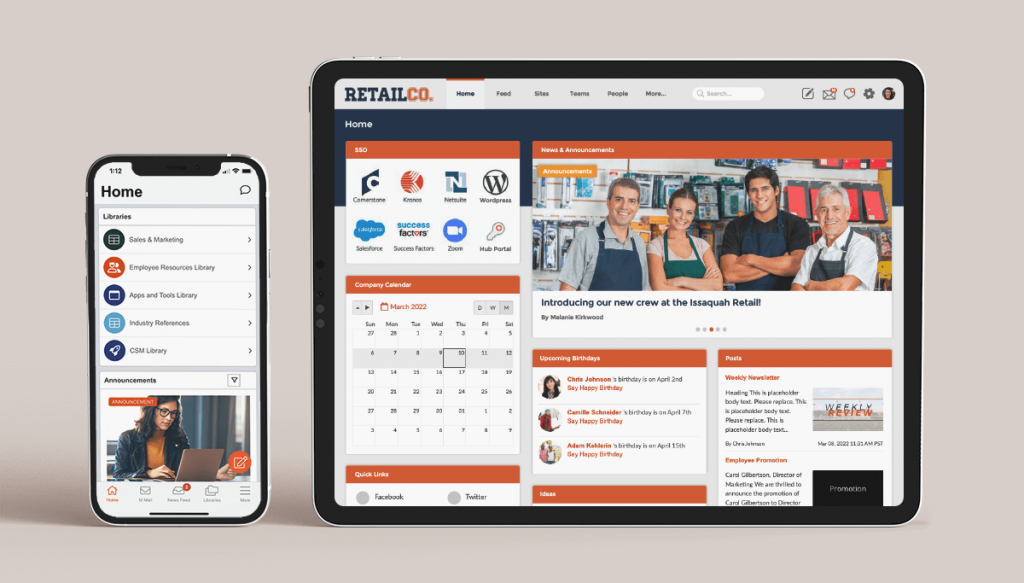
MangoApps stands out by offering a broad set of capabilities: communication, recognition, knowledge, operations, learning and tasks — all in one platform. Many traditional employee engagement apps focus narrowly on social feeds or mobile updates, but MangoApps gives you a much wider capability set. Organisations transition to MangoApps when they realise they need more than engagement: they need communication, operations and knowledge all in one place.
This makes MangoApps particularly appealing to organisations on tighter budgets who still need a rich engagement app but also want shift-based workflow, operational tools, mobile communication and knowledge hubs. The value proposition is strong, especially for companies balancing engagement and operations.
Pricing for MangoApps is typically tiered and modular the vendor asks you to contact them for specific user-based pricing. For current packages and offers, you should see the MangoApps website.
How it compares to Blink
It offers far broader functionality, making it a popular budget-friendly Blink replacement.
Strengths
-
Wide feature set
-
Affordable
-
Suitable for both frontline & office staff
Limitations
-
Less modern UI
-
Can feel overwhelming
Best for
Cost-conscious organisations needing broad functionality.
11. Beekeeper — Best for Operational Frontline Teams
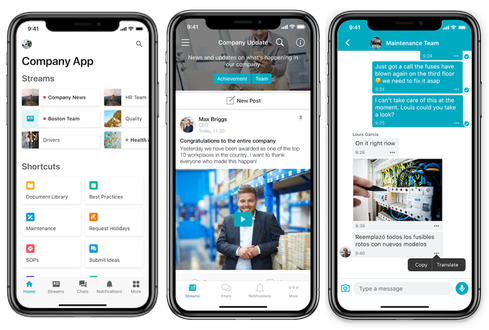
Beekeeper is built specifically for operational, frontline and shift‐based teams, providing mobile-first engagement plus workflow, task, checklist and shift management features. While many engagement apps focus on social recognition or mobile updates, Beekeeper combines these with operational tools that matter day-to-day for frontline workers. Organisations often make the move to Beekeeper when they determine their current engagement app cannot support operational workflows for frontline staff.
This means Beekeeper is ideal for companies where the engagement app isn’t just “nice to have” but needs to support real operational communication, workflows and tasks alongside recognition. The mobile experience is strong, the shift tools are tailored for frontline workers, and the app is designed for immediate adoption.
Pricing is again custom and varies by use-case (shift-heavy workforce, number of users, mobile vs desktop). For exact pricing you should contact Beekeeper’s sales team.
How it compares
Blink = communication
Beekeeper = communication + operations
Strengths
-
Purpose-built for frontline work
-
Strong automation & workflows
-
Excellent shift tools
Limitations
-
Not an intranet
-
Limited content structure
Best for
Hospitality, logistics, manufacturing, transport.
12. Sociabble — Best for Advocacy & Social Amplification
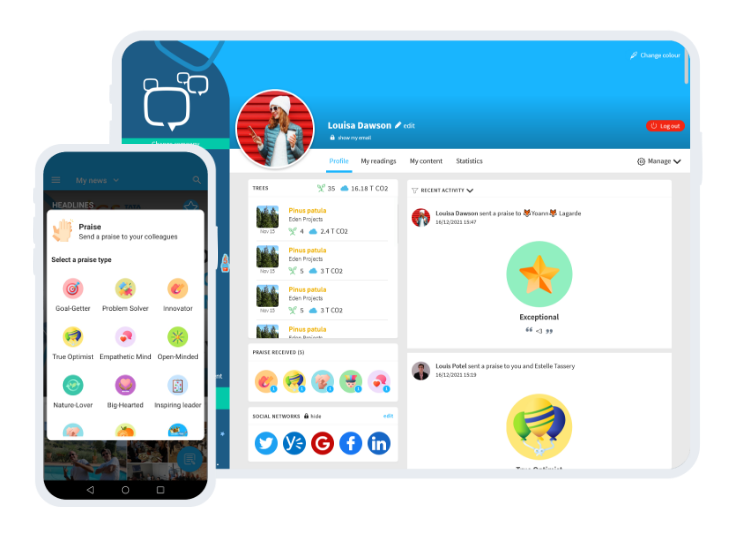
Sociabble focuses on engagement through advocacy, social sharing and employee voice — rather than purely corporate communication. While many engagement apps focus internally on updates and recognition, Sociabble adds an external dimension: sharing, gamification and amplification. Organisations often switch to Sociabble when they want to harness employee advocacy, brand content and social-sharing features embedded into the engagement app.
It helps connect employees to brand values, encourage content sharing, social posts and connections beyond the organisation. The app still works internally but has a bias toward advocacy-driven engagement rather than structured policy or knowledge delivery.
As with many enterprise engagement platforms, pricing is custom-quoted. For current packages, you should request a quote from Sociabble’s website.
How it compares to Blink
-
More external-facing
-
More gamification
-
Less suited to structured internal comms
Strengths
-
Great for advocacy campaigns
-
Gamification tools
-
Engaging social UX
Limitations
-
Not a full EX/intranet platform
-
Limited governance
Best for
Sales & brand-led organisations.
Final Thoughts: Choosing the Right Blink Alternative
Blink remains a strong mobile-first platform, particularly for quick, frontline communication. But many organisations eventually need more, whether that’s structured content, governance, analytics, personalisation, or a platform that supports both frontline and office-based employees.
The best Blink alternatives provide the depth, intelligence and unified experience required for today’s digital workplace.
If you’re prioritising:
-
AI-driven communication
-
Structured content & governance
-
Mobile + desktop parity
-
A single platform for every employee
…then Oak Engage stands out as the strongest and most future-ready Blink alternative in 2025.
Frequently Asked Questions
1. Why do organisations look for Blink alternatives?
Many organisations outgrow Blink when they require deeper content management, better governance, AI-driven personalisation or a solution that works for both frontline and desk-based employees. As communication needs evolve, teams often need more structure, more targeting and more analytics than Blink can offer.
2. What is the best Blink alternative in 2025?
Oak Engage is the top Blink alternative because it combines a modern intranet, structured content, personalised communication and a powerful mobile app. It serves frontline, hybrid and office-based employees in one unified platform — something Blink cannot do at scale.
3. Which Blink alternative is best for social engagement and culture?
Workvivo is the strongest choice for organisations that prioritise culture, recognition and employee-generated content. Its social feed, shoutouts and storytelling tools offer a more polished and visually engaging experience than Blink.
4. Which Blink alternative is best for enterprise communications teams?
Staffbase excels for communications teams needing professional editorial workflows, governance, multi-language support and branded communication channels. It is ideal for large or global organisations with mature comms needs.
5. Which Blink alternative is best for personalised or automated communication journeys?
Firstup is the best option for enterprises that need automated, behaviour-based messaging across multiple channels. It is far more sophisticated than Blink when it comes to segmentation, orchestration and data-driven delivery.
6. Which Blink alternative is best for regulated or compliance-heavy industries?
Interact is the leading choice for organisations with strict policy, governance or compliance workflows. It includes mandatory reads, document lifecycle management and strong enterprise search — areas where Blink is limited.
7. Which Blink alternatives integrate best with Google Workspace?
LumApps and Happeo provide the strongest native integrations with Google Workspace. They synchronise deeply with Google Drive, Gmail, Google Chat and shared drives, making them ideal for Google-first organisations.
8. Which Blink alternative is best for frontline operational teams?
Beekeeper is the top choice for operational frontline environments such as retail, hospitality, manufacturing and logistics. It includes workflows, checklists, shift tools and automation — beyond the communication-only model of Blink.
9. Are there Blink alternatives with better governance and content structure?
Yes. Unily, Simpplr and Oak Engage all provide significantly stronger content governance, structure, lifecycle management and clarity compared to Blink’s feed-based approach.
Change the way you work. Empower your people
We offer a free and personalised demo service, showcasing our intuitive and easy to use platform.
